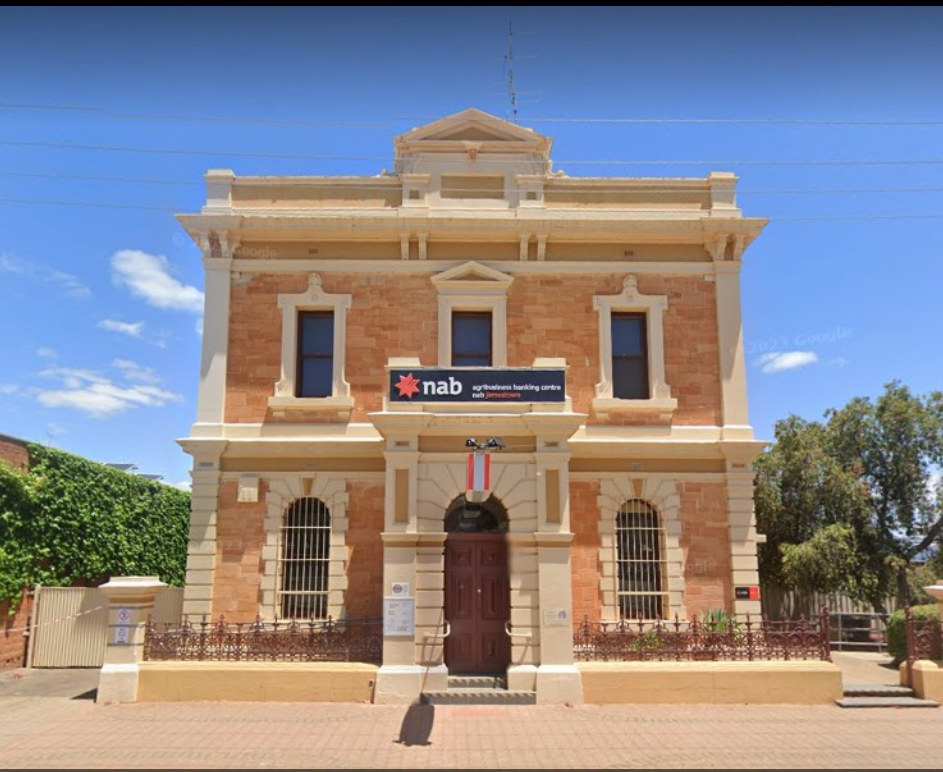
NAB's branch in Jamestown, SA, will close on July 1st
The boat has pretty much sailed when it comes to countering the closure of bank branches, whether in rural, regional or urban areas.
Over the 15 months a Senate inquiry into bank closures in regional Australia has been running another 86 regional bank branches have closed or had closures announced since the Senate inquiry was announced on 8 February 2023, according to the forensic research of independent journalist Dale Webster.
(This is without factoring in the recent brand reshuffle by Commonwealth Bank of the Bankwest network in Western Australia, announced last month. This preserves Bankwest’s regional network of 15 branches, which will be rebranded under the main CommBank brand, while all 45 urban Bankwest branches will be closed by the end of the year).
“By far the bulk of these branch closures have been by NAB, but Westpac still went ahead and closed smaller branches such as Coober Pedy despite publicly claiming to have honoured their moratorium” Webster told Banking Day.
“And Westpac and Commonwealth have continued to close branches in larger regional areas such as the Gold and Sunshine coasts and Newcastle.
“A bank branch (mainly NAB’s) has been closed in regional Australia every five days since the inquiry was announced” Webster said.
High-impact negotiation
masterclass
July 9 & 16, 2025
5:00pm - 8:30pm
This high-impact negotiation masterclass teaches practical strategies to help you succeed in challenging negotiations.
ANZ, meanwhile, has assertively pushed ahead with its strategy of making a material proportion of its branch network cashless.
S&P Global in a report earlier this month said that among major banks Westpac leads the move to shut bank branches nationally, with 167 closures last year, a number that spans urban and regional areas.
S&P Global Market Intelligence reported that Commonwealth Bank closed 73 branches in 2023, ANZ closed 72 and NAB closed 63.
APRA counted more than 6000 bank and credit union branches around Australia in 2001, the first year it collated data on ‘points of presence’.
This number fell to 3588 branches by June 2023, according to APRA’s latest count.
However, the reliability of this annual APRA accounting, known as the authorised deposit-taking institutions' points of presence statistics, is one of the topics the Senate’s final report is likely to address, informed in part by Webster’s research.
Where the senators may land their most relevant recommendations is less easy to pick.
More than likely there will be analysis (and dismay) around the Branch Closure Support Protocol produced by the Australian Banking Association in June 2023.
This protocol, in theory, governs the steps that banks must follow when closing branches, implementing the recommendations of the federal government’s Regional Banking Taskforce inquiry into branch closures that was initiated by the former coalition Government in October 2021 and concluded by the Labor Government in September 2022.
Wendy Streets, national president of the Finance Sector Union, yesterday sledged the entire industry when asked about this ABA protocol at the inquiry’s 13th and final public hearing on Queensland’s Bribie Island yesterday.
“They all chose to ignore it” Streets said.
“Because there are no consequences for them to not follow the code.”
The FSU in its submission advocated for a UK-style protocol. Based on the UK model a revamped code would have three phases; phase one is the initial announcement, phase 2, post announcement and pre-closure, phase 3 is post closure.
“This code should be monitored and enforced by the appropriate regulator and strict penalties applied when the code is breached” the FSU said.
Streets pointed to the findings of Craig Emerson’s recent interim report from his review of the Food and Grocery Code of Conduct, the chief finding of which is that this voluntary code be made mandatory.
Then there is the South African model. The submission by Andy Schmulow of the University of Wollongong outlining the regulatory system in South Africa where a bank can’t be closed without meaningful consultation and replacement services provided might form the foundation for a recommendation on this.
The fact that Dr Schmulow was asked to appear in person is an indication that his advice is being looked at closely.
Then some form of right of access or community service obligation on banks might find favour with the committee.
Bank@Post will be scrutinised, praised and probably dismissed as a relevant option to assure a minimum standard of banking services in the bush. Though the final report will probably call for Licensed Post Offices to be better paid by banks for the (cash heavy) services they do provide. ANZ and maybe Bank of Queensland will be chastised for having quit Bank@Post in recent years.
The most daring proposal might be for a shared services model for rural bank branches, not that there is any enthusiasm for this in the industry.
That old saw, the re-entry of the Commonwealth government into the business of banking, potentially in collaboration with Australia Post (in the manner of Kiwibank in New Zealand), found favour among many citizens who made submissions or gave evidence, but won’t go anywhere.
If the committee is gutsy, it might challenge the seemingly received wisdom that older people and the elderly in particular are at a distinct disadvantage amid the popular embrace of digital payments and the digitisation of every (banking) business process.
The Australian Bureau of Statistics yesterday published insights on “How Australian generations spent their time on recreation and leisure.”
One subset of this data, on general internet and device use, shows that baby boomers are as switched on as millennials. Even for the interwar generation, while device use is lower, it is not low.
One final topic which may animate the committee is already one of the biggest industry themes of 2024: preserving (and even mandating) access to cash.
It is due to report next month.